
The Award Winning
Monthly Newsletter of the Anchorage Coin Club
Volume 14, Number 1 January, 2001
January Membership Meeting:
Wednesday January 3rd, 2001 Central Lutheran Church 7:00 PM Open, 7:30 PM Meeting

"Foes of the Crusaders- The Mamluks 1248-1290 AD"
"Building a Set of Washington Quarters"
FROM YOUR EDITORS
The Anchorage Coin Club Christmas Party 2000 was a wonderful time. We had more than seventy people there. The food was the best we had ever had with much of it coming straight out of our members hot ovens. The winner was chosen for the biggest raffle prize we had ever given away (a complete set of Buffalo Nickels). She was not there, we tried calling her on a cell phone but she was out of range so she will have to find out about her big Christmas present from Santa. We gave out 31 door prizes to randomly chosen people who picked their mystery prize from a box of wrapped gifts. Awards were also given out. Mark Nagy received the Bill Garing Memorial Award for Numismatist of the Year. He has helped us by giving informative presentations at our monthly meetings as well as passing out information to the public at the coin show in Wasilla. Corey Rennell received the Young Numismatist of the Year award. Corey has supported the club in every way a young man could including calling out questions at the YN Jeopardy Game. He has also matured from a fifty cent opening bid to a fifteen dollar opening bid (something we can only hope for in another YN with a one dollar opening bid).
The annual coin auction was the main event of the evening and was the biggest Christmas coin auction we ever had. There were 150 lots registered in the auction when we started and 7 more showed up that evening. Coins in the auction ranged from a small gold coin from 17th century India that went for $18, a proof Bahamas half dollar that went for $2, to a US Liberty ten dollar gold piece that went for $205, and an XF Hawaiian sesquicentennial commemorative that went for over seven hundred dollars. There were plenty of coins for kids of all ages. To keep the auction from running on much too long we stopped the auction sequence at 8:45 PM and asked for requests to auction off particular coins in the remaining lots. That evening some 111 lots were auctioned and rest of the auction lots were held over. These remaining lots will be auctioned at our club’s January 3rd membership meeting. In the remaining lots are some nice ancient coins submitted by Rick Bilak and some very rare error coins from Bill Fivaz.
It was a peaceful evening with good food and good friends. Even with the auction going on, Bill Hamilton presented coins and took bids with a smooth, easy pace. When the auction ended there was a 3.5 earthquake just north of town. Robert Hall, the club treasurer, did the accounting and Robin Sisler handed out lots to the lucky bidders. Meanwhile the chairs got stacked and tables put away. The leftover food (and there was a lot of it) got handed out. Finally, Larry Nakata loaded up his car with the leftover bags of chips to bring to future meetings, and minutes before 10:30 pm we were out of there… into the warmest December night we could ever remember.
We want to wish all of you a Merry Christmas and a Happy New Year…..Your
Editors.
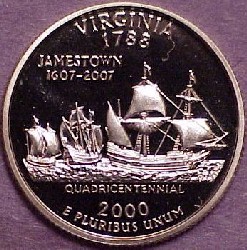 |
MEMBERSHIP NEWS
Schedule of Events for the Month of January
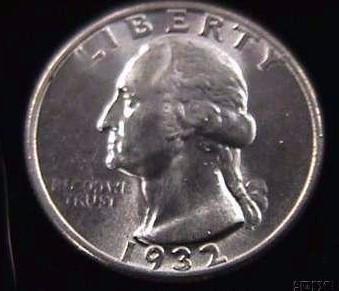 |
A great time was enjoyed by all at our December 7th Christmas Party. A number of YNs (Young Numismatists) attended that party which featured our coin club’s Christmas Auction. Some $163 in YN Bucks were given to various YNs who earned those dollars through our YN Bucks contest. Those YN Bucks were used to bid on coins featured in our club’s auction. Our YNs got a lot of nice coins that evening.
Congratulations goes to YN Corey Rennell for becoming our club’s Young Numismatist of the Year. Corey received a nice award for his achievements. He has certainly earned that award with his volunteer efforts in our club activities….especially with the YN Program.
At the time of the writing of this article, the year 2000 is coming
to a close. In looking back, we had a good year in the YN Program. We saw
a great YN Coin Auction in May. There were lots of education programs held
at the monthly YN meetings. Our YNs did a nice coin display at the Loussac
Library here in Anchorage earlier this year. We had a great summer picnic
in July. YN Sarah Bilak had a opportunity to go to the ANA Summer Conference
under our club’s scholarship program this past summer.
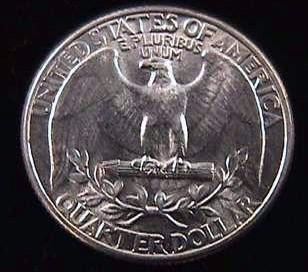 |
Our YN membership continues to increase in size. We have a lot of young YNs in the 9-11 year old category that joined our YN Program this year. The program thrives.
Our next YN meeting will be held on Friday, January 12th at the Central Lutheran Church (7 PM). To start off the new year for our YN Program, member Richard Bilak will be giving a session on “Ancient Coins”. There will be lots of ancient coins for our YNs too see at this meeting. Who knows what ancient coins may be given out that night to add to your collections. Show up and you’ll find out.
Merry Christmas and a Happy New Year…..Larry Nakata.
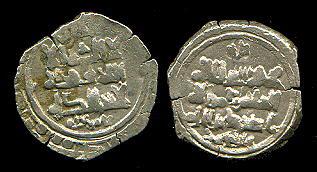 |
“FOES OF THE CRUSADERS-THE MAMLUKS 1248-1290 AD” by Richard Bilak (Member # 176)
This article started back in August 99. I thought that this would be a short article on the “Foes of the Crusaders”. I was wrong. The more research, the longer the article became. Soon the article was taking on a life of it’s own. I finally decided to write the article into 3 parts: Zangids, Ayyubids, and Mamluks. Why are the Mamluks first? Luck of the draw mostly, it was the first book I grabbed on the bookshelf. I hope you enjoy the article as much as I enjoyed the research.
The Crusades were the endgames of a 200 year chess match. In 1248, King Louis IX of France started out on the seventh Crusade. By the time the seventh Crusade ended, Louis IX had been captured and escaped. The Mamluks seized Egypt after the death of Al-Salih Ayyub and assassinated his son Turan-Shah in AH648/1252 AD. Damascus and Aleppo were occupied by the Mongol Hulagu in AH658/1260 AD. The Mongols were then defeated by Qutuz at the battle of Ayn Jalut AH658/1260 AD. After routing another Mongol attack that resulted in the destruction of Aleppo, the Mamluks had established themselves as the power in the Lavent. Next up in AH690/1291, the Mamluks crushed the Crusaders at Acre. This effectively brought the Crusades to an end.
One of the things that I find interesting is the history of the Crusades
from the Arab point of view. There are several good books out there if
you read Arabic. I only read Arabic on coins and even that not real well.
One excellent book is Francesco Gabrieli’s “Arab Historian of the Crusades”.
I would be remiss not to mention the one by Amin Maalouf “The Crusades
Through Arab Eyes”. From Gabrieli’s book I would like to include the short
version of the fall of Acre.
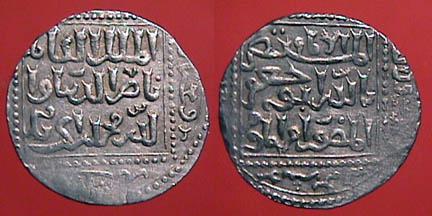 |
The Fall of Acre….Abu I-Fida: “One night during the siege of Acre the Franks made a sortie. They put the sentries to flight and reached the tents. They became entangled in the guy-ropes. One knight fell into the latrine trench. A soldier from one of the Amir’s detachments killed him quickly. The Amir’s troops turned out in overwhelming numbers and the Franks turned tail and fled back to the city, leaving a number of dead. The next morning Al-Malik al-Muzaffar, Lord of Hamat, had a number of heads attached to the necks of captured horses and presented them to the Sultan al-Malik al-Ashraf.”
“The blockade was continually reinforced until God granted to the attackers victory over the city on Friday 10 nJumada II/ 17 June 1291. As the Muslims stormed the city some of the citizens took to the sea in boats. Within the city were a number of well fortified towers, and some Franks shut themselves inside them and defended them. The Muslims killed vast numbers of people and gathered immense booty. The Sultan forced all in the towers to surrender, and they submitted to the last man, and to the last man were decapitated outside the city walls. At the Sultan’s command the city was razed to the ground.”
“An amazing coincidence occurred; the Franks seized Acre from Saladin at midday on 17jumada587 and captured and killed all the Muslims therein; and God in his presence destined that this year it should be reconquered at the hand of another Saladin, The Sultan al-Malik al-Ashraf.”
“Soon thereafter the Franks gave up the Levant and the well fortified cities were demolished.”
Translated literally the term “mamluk” means owned. This does not equate to slavery as we accustomed to. A mamluk was “acquired” either by purchase or capture. He was then trained as a soldier, bodyguard, or gentleman-at-arms. A mamluk was brought up and cared for my his owner. If a mamluk’s courage and services to his master were outstanding, the mamluk could be eligible for manumission (freedom). If the mamluk was really gifted he could attain the rank of Amir. Being a mamluk carried no stigma, quite the opposite. Being proud of having served the great princes and lord and thinking themselves as the ruling class of the country (Egypt in this case).
Who were the Mamluks during the Crusader period?
Aybak AH648-655/1250-1257 AD. One of the leading Mamluks of his time, he became the newly elected King of Egypt. Married Queen Shajar al-Dur. Aybak put down several challenges to his power and consolidated the government.
Ali I AH655-657/1257-1259. The incompetent son of Aybak who was pushed aside by the great general Qutuz.
Qutuz AH657-658/1259-1260. The army under his command wiped out the remaining forces of the Ayyubid al-Mughith Umar. Then in a hard fought battle in Syria at Ayn Jalut the Mamluks defeated the Mongols with huge losses. On his way to Cairo, Qutuz was murdered by rival Amirs.
Baybers I AH658-676/1260-1277. Probably one of the greatest rulers in
the Islamic world. With his election as Sultan began one of the most glorious
periods in Moslem Egypt. First he wiped out the Crusader threat on the
Syrian coast. Second, he defeated the Mongols occupying Iraq and Asia Minor.
On the home front Baybers handled the affairs of state with skill, wisdom,
and energy. His government was just, enlightened, and he was popular with
his subjects.
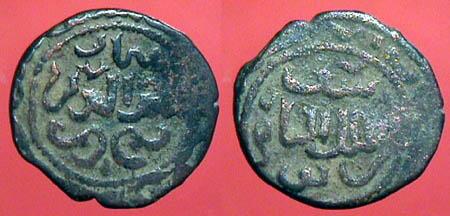 |
Unfortunately his two sons, Barak Qan AH676-679/1277-1279 and Salmish AH678/ 1279 AD were unable and incapable of carrying on the family tradition.
Qala’un AH678-689/1279-1290 AD. Near the end of 1281, Qal’un fought with the Mongols and wiped them out near Hims. Next he finished off what was left of the Crusaders on the Syrian coast. There was nothing left of the Christian forces by the time Qala’un died in 1290.
For the first ten years Mamluk coinage suffered from an identity crisis. The coins looked so similar to Ayyubid coinage that they are referred to as “Pseudo-Ayyubid type”. When Baybers was finally established as Sultan in AH658 he authorized new designs for gold and silver.
Baybers I began to mint 3 new designs of coinage. They were:
A. Square in circle type.
B. A lion reverse type similar to the drams of Cilicia.
C. A new type with the Lion passant on the reverse.
For the next 40 years the design of Mamluk coinage did not change much.
The denominations used by the Mamluks were as follows: Gold Dinar at 4.25 grams. Earlier dinars varied quite a bit in weight and were traded by weight. They were known as Bullion dinars.
Silver Dirhams. The original weight of 2.9 grams was attempted, however inflation and the scarcity of silver at times affected the weight.
Copper Fuls. The workhorse of everyday transactions weighted anywhere from 2.9-4.25 grams and at times was treated as a token coinage.
The mints during this period (1250-1290 AD) were Cairo, Alexandria,
Damascus, Hamah, and Aleppo. Cairo and Alexandria did the bulk of the gold
and silver mintage. Damascus did all of the copper…..Richard Bilak.
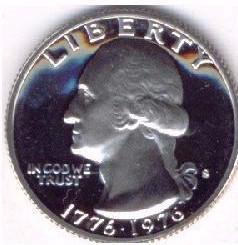 |
“BUILDING A SET OF WASHINGTON QUARTERS” by Mike Nourse (Member # 94)
So, you want to build a complete set of Washington quarters from their inception in 1932 to date? No problem! Washington quarters have been in the doldrums for years. They tend to accumulate in a dealer’s inventory and sit around for years since few people collect them, preferring to spend their hard earned coin budget on Indian cents, Morgan dollars, and gold coins. You often find Washington quarters priced near wholesale levels just to get this dead inventory to move in order to free up the cash for coins with a brighter future.
Whoops…sorry! The above paragraph would have been a great start if I was writing this three years ago in 1997. However, this is not 1997, this is 2000, and the state quarter program has brought the recently comatose Washingtons right to the center of attention. They are now much tougher to get hold of in quantity and prices have advanced smartly. In my own experience, my inventory has dropped from around two double row boxes to a dozen or so. On the other side, those dozen boxes are certainly worth more at current price levels than the 20 boxes at 1997 levels.
Has the Washington quarter collection gotten out of sight in terms of valuation? Not at all! A nice set can still be built without spending an extraordinary amount of money although it is not cheap either.
There is a basic division that separates the Washingtons into two groups: the silver issues from 1932 through 1964, and the clad issues from 1965 to present.
There is not much to discuss about the clad issues. All of them have
mintages in the hundreds of millions which is plenty to go around. Even
the Proof issues have mintages that fall in the range between three quarters
of a million and four million. If these Proof mintages seem small next
to the hundreds of millions for the Philadelphia and Denver issues remember
that the survival rate is near 100 percent for the Proofs while most of
the P’s and D’s have been circulated. The reality is that none of the clad
issues are rare or even remotely scarce.
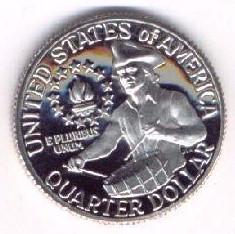 |
The only clad issues that are not easy to locate in large quantities are the circulation coinage from 1982 and 1983. No mint sets were produced in those two years so the only supply available is the rolls and bags that were set aside in those years. As for the new statehood quarters, they are immensely common in uncirculated condition. A huge percentage of the original mintages (which are reasonably high) have been kept out of circulation in the form of rolls and bags set aside by speculators and dealers. While the price of the early 1999 statehood quarters is a bit high, I think these price levels may drop as the speculators sell their hoards.
So, back to our original objective of building a set of Washington quarters from 1932 to date. As we have seen, there are no scarce issues after 1965, so there are two ways to attack this group. You can go around and buy these coins one by one if you wish to try and cherrypick the absolute best you can find. Option two is to simply buy the complete set from 1965 to date from one of the dealers who build these sets.
When buying the full set from 1965 to date, there is little chance that the set will include any sliders. Virtually all of these coins are pulled from original rolls, bags or cut out of mint sets. This being the case, it is probably a better bet to just go ahead and buy these coins as a set. As a bonus, they usually come in a nice album that can be used to hold the full set from 1932 to date. Buying the full 1965 to date run as a set greatly reduces the cost as there wil be much less of a markup on the set versus buying the coins one by one. If there is a dud or two included in the set, these can easily be upgraded at your leisure and the cost will still be lower than buying the coins one by one. What will it cost? Figure on about $250 or so for the full set in an album, but prices will fluctuate.
Now, on to the silver issues produced from 1932 to 1964. Again, you can buy these coins as a complete set or one by one. In this case, I suggest that you assemble these piece by piece as the quality will be much more variable and the savings achieved by buying a full set will be much less. While it is much more time consuming and a bit more expensive to pick out these quarters one a time, I think you will end up with a much nicer set.
There are 83 separate issues in the silver set. You will need to decide if your finances allow you to build this set in uncirculated condition or if it must be assembled using circulated coins. Another alternative is to buy the later silver issues (usually defined as 1941 through 1964) in uncirculated and the earlier coins from 1932 through 1940 in circulated condition.
To build the 1941 through 1964 set in circulated condition will cost little more than scrap silver value of about $1.50 per coin. It may take a bit of searching through several dealers junk silver boxes but you may well be able to find every one of the 61 different quarters minted from 1941 through 1964 in this way. Even if you have to buy a few of these coins out of the dealer’s trays, they will not be priced must above scrap silver value in average circulated value. Therefore, you are looking at about $100 for these 61 coins in circulated condition.
In uncirculated preservation these coins will obviously be more expensive, in the neighborhood of $500 through $550. As with most silver coins, Washington quarters generally have fabulous luster when they are uncirculated and are very attractive. Again, you can buy the uncirculated set from 1941 through 1964 as a group but will probably end up with a nicer set if you build it yourself piece by piece.
In terms of the quarters produced from 1932 through 1940, these 22 coins are usually collected in circulated condition. The reason, of course, is the difference in price. In nice, high circulated condition of around Very Fine, you are looking at about $250 to $275 for these 22 pieces. On the other hand, it is almost ten times as much for the same coins in uncirculated , in the area of $2250 to $2500.
If you put together uncirculated coins for 1941 through 1964, a nice compromise might be to buy the 1932 through 1940 pieces in About uncirculated condition at a cost of about half as much as the true uncirculated coins.
So, we have seen that there are many different ways to build a complete
set of Washington quarters. As usual in coin collecting, the final decision
is generally made on a basis of available finances. Besides being a very
popular series right now on account of the state quarter program, it has
become quite a large and impressive set, now covering almost 70 years and
over 200 coins. Which ever way you choose to build your set have fun with
the challenge of assembling such a large set of coins….Mike Nourse.
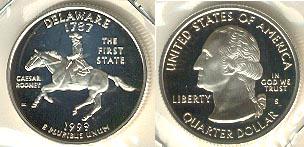 |
Carryover Auction Lots for the January 3rd Membership Meeting
Mail bids will be accepted for the January Auction. MB= Minimum Bid
LOT#
86. 1801 Large Cent (Clip) AG. MB 10
88. 1864 Two Cent Large Motto RPD and clip XF. MB 19.50
89. 1942-P Mercury Dime Uncirculated/ FSB
90. 1944-S Washington Quarter MS63. MB 12.50
91. 1950-S Washington Quarter Ch BU P/L Obverse. MB 18
99. 1999-P Lincoln Cent Deep Die Cap PCGS MS65 Red. MB
310
100. 1999-P 1c/10c Double Denomination PCGS MS66.
MB 475
101. Love Token. Mercury 10c on a Walking Liberty Half shaped
in the form of a heart. MB 25
102. Scenic Gold Love Token Locket. MB 37.50
103. Middlesex 1795 Conder Token Ch Uncirculated. MB 75
104. Middlesex Conder Token Ch Uncirculated. MB 75
105. CambridgeshireToken Ch Uncirculated. MB 75
106. Middlesex 1795 Conder Token Ch Uncirculated. MB 95
107. 1797 Great Britain 1 Pence Cutout coin. MB 23
108. One (1) BU Roll of 1999-P Delaware State Quarters. MB 35
109. 1796 Half Cent (Copy) Double Struck coin Gem BU. MB 25
110. 1796 $1 (Copy) Cracked die/CUD/ die clashes on coin Gem BU.
MB 125
111. Punic, Carthage, AE20, Obv: Pegasos/ Rev: Palm Tree/ From the
time of Hannibal, VF MB 25
112. Sicily, Syracuse, AE18, 345-317 BC, Obv: Apollo/ Rev: Pegasos/
VF/ SG1199 MB 90
113. Ionia, Ephesos, AE16, 280-258 BC, Obv: Bee/ Rev: Stag/ VF/ SG4406
MB 30
114. Macedon, Autonomous, AE18, 186-165 BC, Obv: Head of River god
Stryman/ Rev: Trident/ F MB 10
115. Egypt, Ptolemy VI, AE29, 180-145 BC, Obv: Zeus Ammon/ Rev: 2 Eagles
on thunderbolt/ VF/ SG7900 MB 40
116. Judea, Alexander Jannaeus, AE Prutah, 103-76 BC, Obv: Anchor/
Rev: Wheel with 8 spokes/ XF/ Example of the “Widow’s Mite” MB 35
118. Rome, Caligula, AE As, 47-41 AD, Obv: Caligula/ Rev: Vesta seated/
XF MB 200
119. Rome, Nero, AE As, 54-68 AD, Obv: Nero/ Rev: Temple of Janus
with the doors closed/ XF MB 300
120. Rome, Septimius Severus, AR Denarius, Obv: Septimius Denarius/
Rev: Charging Lion/ VF MB 45
121. Celtic, Barbarous Radiate, VF, Celtic copy of Roman coinage
done after the Romans left Britain MB 10
122. India, AR Karshapana, Mauryan, 320-270 BC, F, a punch marked
coin from the ruler Chandragupta MB 6
123. India, AE unit, Indo-Parthian, 20-55 AD, Gondophares, VF
MB 7
125. India, AR Damma/ 5 mm , Vijaynagar, 1600 AD/ VF MB
5
126. Parthia, AR Drachm, Volagasses IV, 147-191 AD/ VF
MB 35
127. India, Mysore, Gold Fanam, 1782- 1799 AD, Sultan Tipu, Kalikut
Mint/ XF MB 15
128. India, Kushan, AE Tetradrachm, 55- 105 AD, Soter Megas/
VG MB 5
129. India, Kushan, AE ¼ unit, 143-180 AD, Huvishka/ VG
MB 5
131. Crusades, Richard I (The Lion-Hearted), AR Penny, 1189-1199 AD/
Canterbury Mint/ VF MB 30
132. Crusades, Raymond of Poitiers, Billon Denier, Antioch, 1136-1149
AD/ VF MB 25
133. Crusades, Edward I, AR Penny, Canterbury Mint, 1277-1307
AD/ VF MB 20
134. Foes of the Crusades, Mamluk, Shaban I, ½ Dirham,
1345- 1346 AD/ F MB 5
135. Foes of the Crusades, Ayyubid, al Kamil Muhammed, AE Fals,
1218-1238 AD, Cairo Mint/ VF MB 5
136. Russia, Peter the Great, AR Denga (Wire Money), 1709 AD/ VF
MB 20
151. 1900 Barber Dime G
152. 1904 Barber Dime F
153. 1910 Barber Dime G
154. 1912-D Barber Dime XF
155. 1914-D Barber Dime G
156. 1916 Barber Dime G
Club Archivist/ Photographer
Robin Sisler
DUES
The Anchorage Coin Club is a non-profit organization formed to provide information, education, and a meeting place for individuals having an interest in numismatics.
Correspondence Address: Anchorage Coin Club, P.O. Box 230169, Anchorage,
Alaska 99523
Return to: "Top of the Newsletter"